Strategic Development of Organizations and Leading Innovation
VerifiedAdded on 2023/01/17
|13
|3357
|51
Report
AI Summary
This report undertakes a critical review of literature focusing on leading innovation and strategic development of organizations in the 21st century. It begins by defining the fundamental competencies required for leaders to drive innovation and strategic growth, emphasizing the importance of proactive internal interaction, stakeholder rewards, and employee engagement. The report then explores perspectives on innovation in the modern era, highlighting the need for leaders to foster collaboration and adapt to environmental changes. Key factors influencing the evolution of innovation and strategic development are examined, including globalization, technological advancements, and increased business competition. The impact of globalization is discussed, including its effects on business operations and the need for leaders to adapt to changing market dynamics. Technological advancements and their role in enhancing business operations, cost reduction, and global reach are also analyzed. The report concludes by emphasizing the importance of strategic alignment and the need for organizations to adapt to the changing tastes of consumers. The report draws upon various scholarly works and provides a comprehensive overview of the key issues, challenges, and opportunities shaping the leading innovation and strategic development of organizations in the twenty-first century.
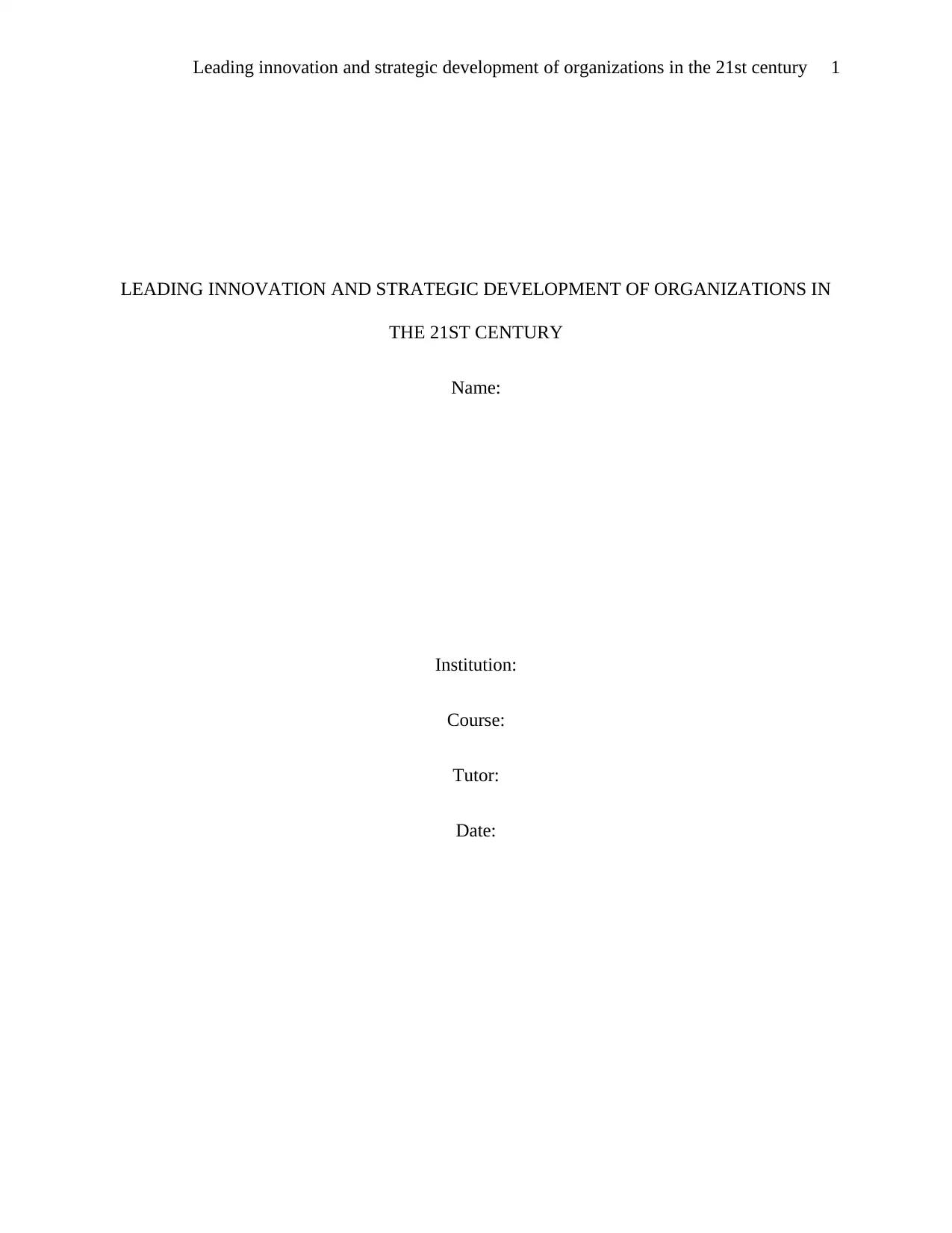
Leading innovation and strategic development of organizations in the 21st century 1
LEADING INNOVATION AND STRATEGIC DEVELOPMENT OF ORGANIZATIONS IN
THE 21ST CENTURY
Name:
Institution:
Course:
Tutor:
Date:
LEADING INNOVATION AND STRATEGIC DEVELOPMENT OF ORGANIZATIONS IN
THE 21ST CENTURY
Name:
Institution:
Course:
Tutor:
Date:
Paraphrase This Document
Need a fresh take? Get an instant paraphrase of this document with our AI Paraphraser
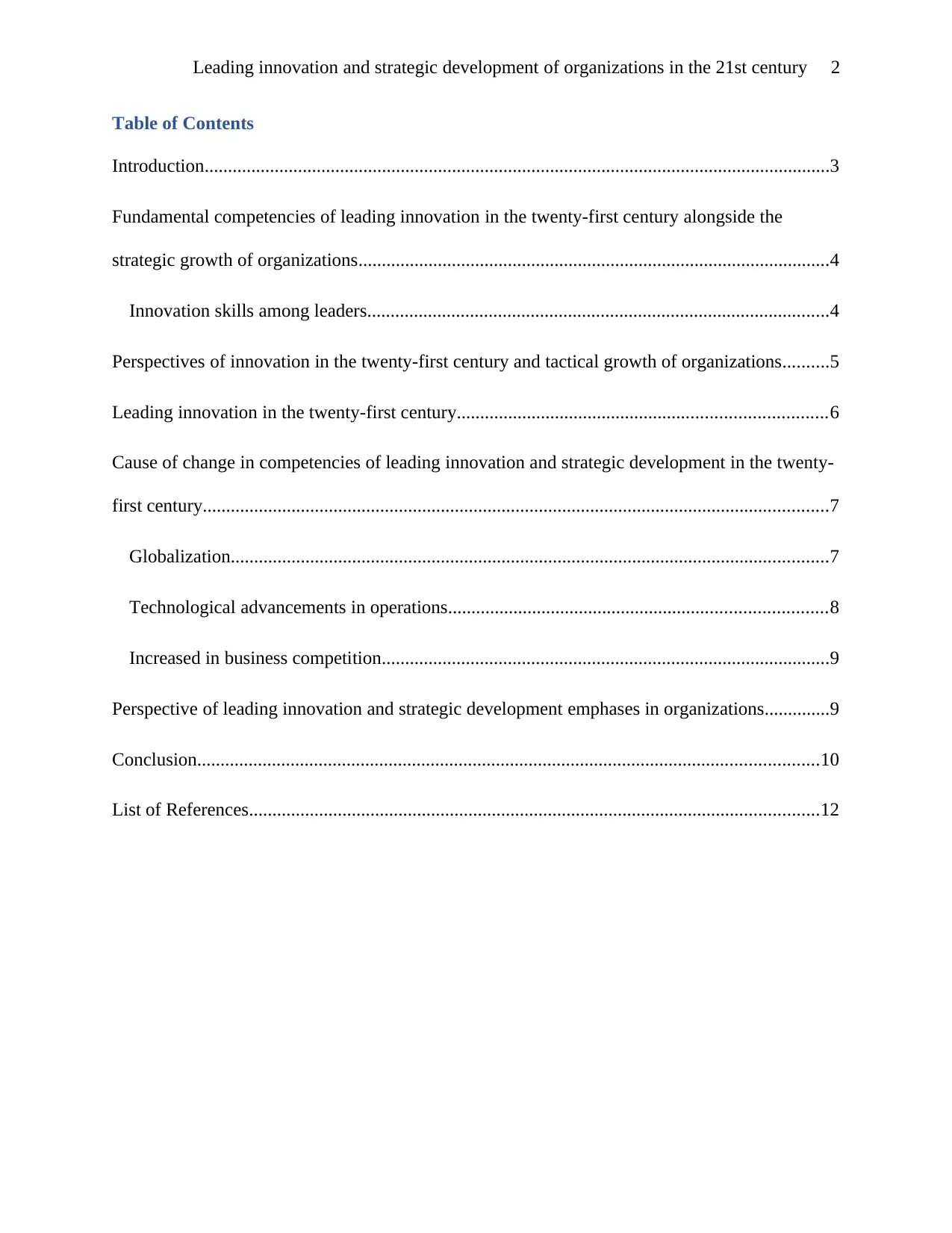
Leading innovation and strategic development of organizations in the 21st century 2
Table of Contents
Introduction......................................................................................................................................3
Fundamental competencies of leading innovation in the twenty-first century alongside the
strategic growth of organizations.....................................................................................................4
Innovation skills among leaders...................................................................................................4
Perspectives of innovation in the twenty-first century and tactical growth of organizations..........5
Leading innovation in the twenty-first century...............................................................................6
Cause of change in competencies of leading innovation and strategic development in the twenty-
first century......................................................................................................................................7
Globalization................................................................................................................................7
Technological advancements in operations.................................................................................8
Increased in business competition................................................................................................9
Perspective of leading innovation and strategic development emphases in organizations..............9
Conclusion.....................................................................................................................................10
List of References..........................................................................................................................12
Table of Contents
Introduction......................................................................................................................................3
Fundamental competencies of leading innovation in the twenty-first century alongside the
strategic growth of organizations.....................................................................................................4
Innovation skills among leaders...................................................................................................4
Perspectives of innovation in the twenty-first century and tactical growth of organizations..........5
Leading innovation in the twenty-first century...............................................................................6
Cause of change in competencies of leading innovation and strategic development in the twenty-
first century......................................................................................................................................7
Globalization................................................................................................................................7
Technological advancements in operations.................................................................................8
Increased in business competition................................................................................................9
Perspective of leading innovation and strategic development emphases in organizations..............9
Conclusion.....................................................................................................................................10
List of References..........................................................................................................................12
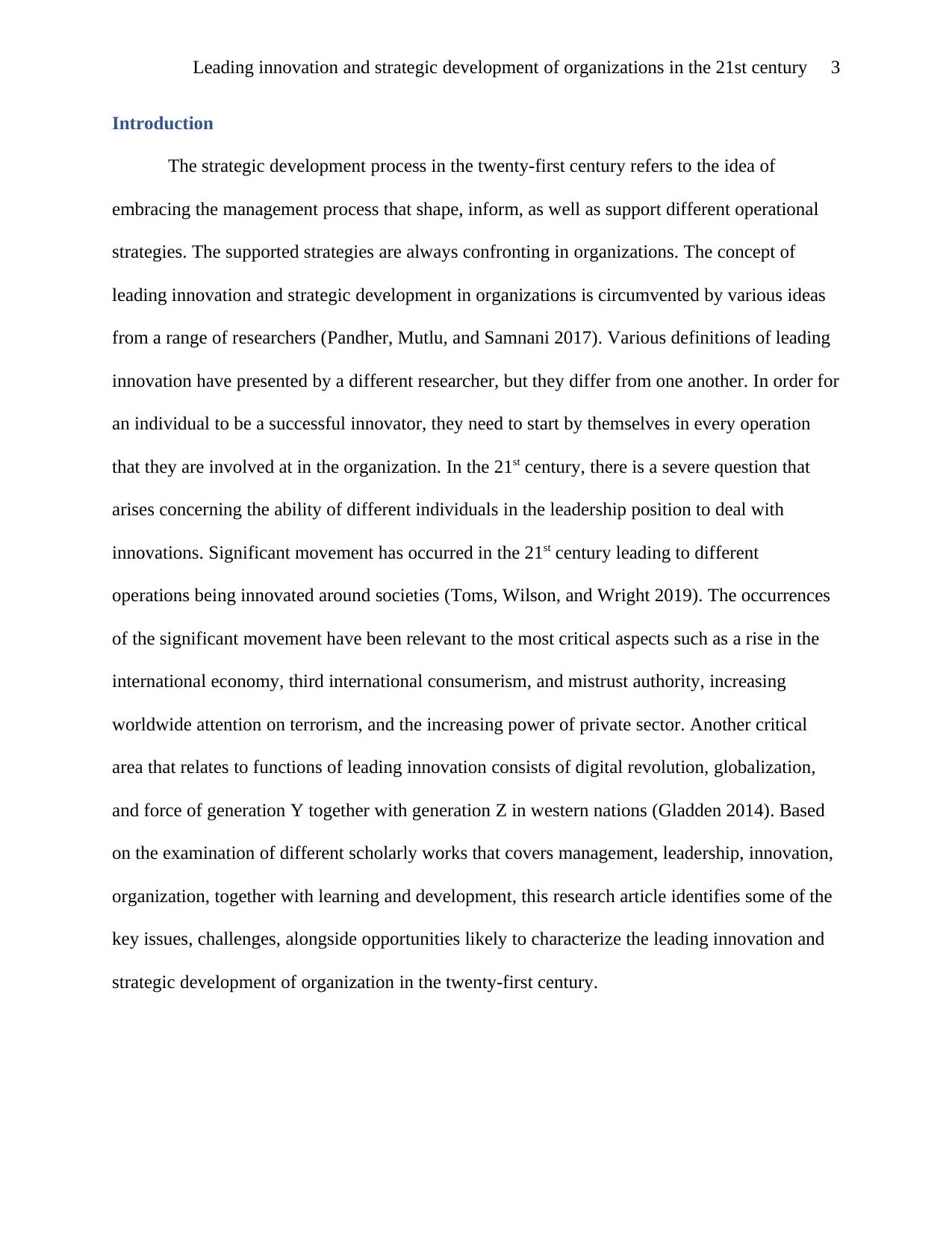
Leading innovation and strategic development of organizations in the 21st century 3
Introduction
The strategic development process in the twenty-first century refers to the idea of
embracing the management process that shape, inform, as well as support different operational
strategies. The supported strategies are always confronting in organizations. The concept of
leading innovation and strategic development in organizations is circumvented by various ideas
from a range of researchers (Pandher, Mutlu, and Samnani 2017). Various definitions of leading
innovation have presented by a different researcher, but they differ from one another. In order for
an individual to be a successful innovator, they need to start by themselves in every operation
that they are involved at in the organization. In the 21st century, there is a severe question that
arises concerning the ability of different individuals in the leadership position to deal with
innovations. Significant movement has occurred in the 21st century leading to different
operations being innovated around societies (Toms, Wilson, and Wright 2019). The occurrences
of the significant movement have been relevant to the most critical aspects such as a rise in the
international economy, third international consumerism, and mistrust authority, increasing
worldwide attention on terrorism, and the increasing power of private sector. Another critical
area that relates to functions of leading innovation consists of digital revolution, globalization,
and force of generation Y together with generation Z in western nations (Gladden 2014). Based
on the examination of different scholarly works that covers management, leadership, innovation,
organization, together with learning and development, this research article identifies some of the
key issues, challenges, alongside opportunities likely to characterize the leading innovation and
strategic development of organization in the twenty-first century.
Introduction
The strategic development process in the twenty-first century refers to the idea of
embracing the management process that shape, inform, as well as support different operational
strategies. The supported strategies are always confronting in organizations. The concept of
leading innovation and strategic development in organizations is circumvented by various ideas
from a range of researchers (Pandher, Mutlu, and Samnani 2017). Various definitions of leading
innovation have presented by a different researcher, but they differ from one another. In order for
an individual to be a successful innovator, they need to start by themselves in every operation
that they are involved at in the organization. In the 21st century, there is a severe question that
arises concerning the ability of different individuals in the leadership position to deal with
innovations. Significant movement has occurred in the 21st century leading to different
operations being innovated around societies (Toms, Wilson, and Wright 2019). The occurrences
of the significant movement have been relevant to the most critical aspects such as a rise in the
international economy, third international consumerism, and mistrust authority, increasing
worldwide attention on terrorism, and the increasing power of private sector. Another critical
area that relates to functions of leading innovation consists of digital revolution, globalization,
and force of generation Y together with generation Z in western nations (Gladden 2014). Based
on the examination of different scholarly works that covers management, leadership, innovation,
organization, together with learning and development, this research article identifies some of the
key issues, challenges, alongside opportunities likely to characterize the leading innovation and
strategic development of organization in the twenty-first century.
⊘ This is a preview!⊘
Do you want full access?
Subscribe today to unlock all pages.

Trusted by 1+ million students worldwide
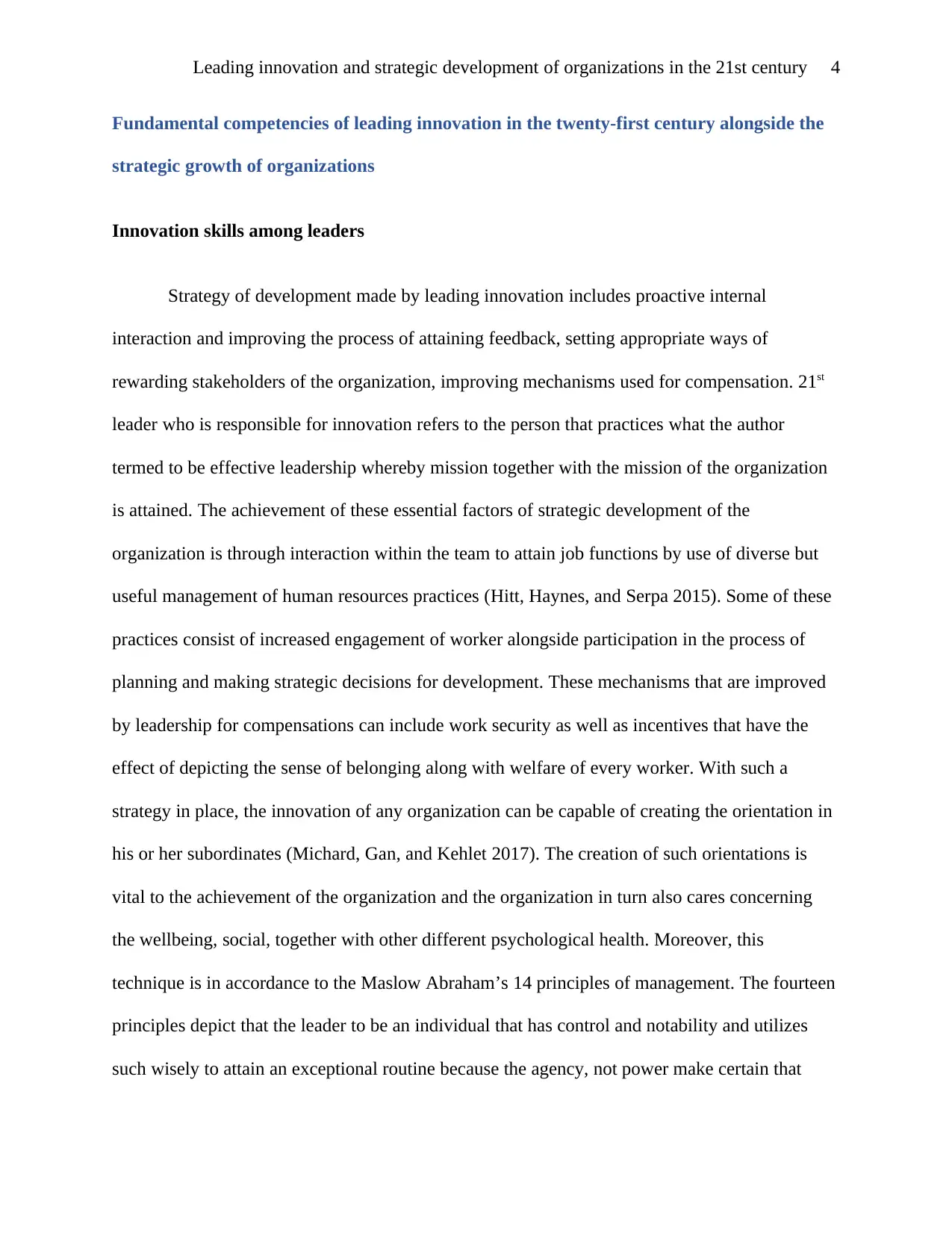
Leading innovation and strategic development of organizations in the 21st century 4
Fundamental competencies of leading innovation in the twenty-first century alongside the
strategic growth of organizations
Innovation skills among leaders
Strategy of development made by leading innovation includes proactive internal
interaction and improving the process of attaining feedback, setting appropriate ways of
rewarding stakeholders of the organization, improving mechanisms used for compensation. 21st
leader who is responsible for innovation refers to the person that practices what the author
termed to be effective leadership whereby mission together with the mission of the organization
is attained. The achievement of these essential factors of strategic development of the
organization is through interaction within the team to attain job functions by use of diverse but
useful management of human resources practices (Hitt, Haynes, and Serpa 2015). Some of these
practices consist of increased engagement of worker alongside participation in the process of
planning and making strategic decisions for development. These mechanisms that are improved
by leadership for compensations can include work security as well as incentives that have the
effect of depicting the sense of belonging along with welfare of every worker. With such a
strategy in place, the innovation of any organization can be capable of creating the orientation in
his or her subordinates (Michard, Gan, and Kehlet 2017). The creation of such orientations is
vital to the achievement of the organization and the organization in turn also cares concerning
the wellbeing, social, together with other different psychological health. Moreover, this
technique is in accordance to the Maslow Abraham’s 14 principles of management. The fourteen
principles depict that the leader to be an individual that has control and notability and utilizes
such wisely to attain an exceptional routine because the agency, not power make certain that
Fundamental competencies of leading innovation in the twenty-first century alongside the
strategic growth of organizations
Innovation skills among leaders
Strategy of development made by leading innovation includes proactive internal
interaction and improving the process of attaining feedback, setting appropriate ways of
rewarding stakeholders of the organization, improving mechanisms used for compensation. 21st
leader who is responsible for innovation refers to the person that practices what the author
termed to be effective leadership whereby mission together with the mission of the organization
is attained. The achievement of these essential factors of strategic development of the
organization is through interaction within the team to attain job functions by use of diverse but
useful management of human resources practices (Hitt, Haynes, and Serpa 2015). Some of these
practices consist of increased engagement of worker alongside participation in the process of
planning and making strategic decisions for development. These mechanisms that are improved
by leadership for compensations can include work security as well as incentives that have the
effect of depicting the sense of belonging along with welfare of every worker. With such a
strategy in place, the innovation of any organization can be capable of creating the orientation in
his or her subordinates (Michard, Gan, and Kehlet 2017). The creation of such orientations is
vital to the achievement of the organization and the organization in turn also cares concerning
the wellbeing, social, together with other different psychological health. Moreover, this
technique is in accordance to the Maslow Abraham’s 14 principles of management. The fourteen
principles depict that the leader to be an individual that has control and notability and utilizes
such wisely to attain an exceptional routine because the agency, not power make certain that
Paraphrase This Document
Need a fresh take? Get an instant paraphrase of this document with our AI Paraphraser
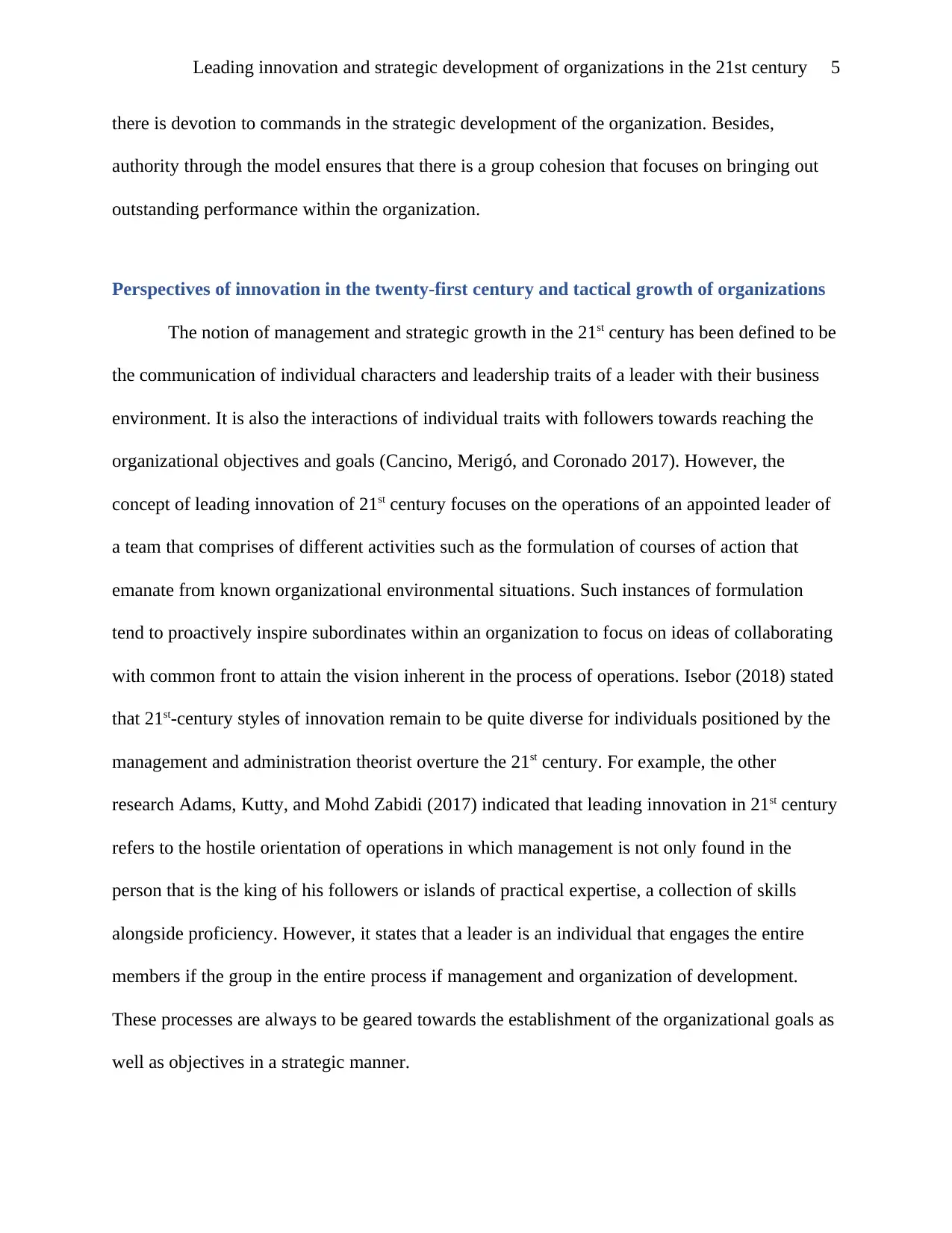
Leading innovation and strategic development of organizations in the 21st century 5
there is devotion to commands in the strategic development of the organization. Besides,
authority through the model ensures that there is a group cohesion that focuses on bringing out
outstanding performance within the organization.
Perspectives of innovation in the twenty-first century and tactical growth of organizations
The notion of management and strategic growth in the 21st century has been defined to be
the communication of individual characters and leadership traits of a leader with their business
environment. It is also the interactions of individual traits with followers towards reaching the
organizational objectives and goals (Cancino, Merigó, and Coronado 2017). However, the
concept of leading innovation of 21st century focuses on the operations of an appointed leader of
a team that comprises of different activities such as the formulation of courses of action that
emanate from known organizational environmental situations. Such instances of formulation
tend to proactively inspire subordinates within an organization to focus on ideas of collaborating
with common front to attain the vision inherent in the process of operations. Isebor (2018) stated
that 21st-century styles of innovation remain to be quite diverse for individuals positioned by the
management and administration theorist overture the 21st century. For example, the other
research Adams, Kutty, and Mohd Zabidi (2017) indicated that leading innovation in 21st century
refers to the hostile orientation of operations in which management is not only found in the
person that is the king of his followers or islands of practical expertise, a collection of skills
alongside proficiency. However, it states that a leader is an individual that engages the entire
members if the group in the entire process if management and organization of development.
These processes are always to be geared towards the establishment of the organizational goals as
well as objectives in a strategic manner.
there is devotion to commands in the strategic development of the organization. Besides,
authority through the model ensures that there is a group cohesion that focuses on bringing out
outstanding performance within the organization.
Perspectives of innovation in the twenty-first century and tactical growth of organizations
The notion of management and strategic growth in the 21st century has been defined to be
the communication of individual characters and leadership traits of a leader with their business
environment. It is also the interactions of individual traits with followers towards reaching the
organizational objectives and goals (Cancino, Merigó, and Coronado 2017). However, the
concept of leading innovation of 21st century focuses on the operations of an appointed leader of
a team that comprises of different activities such as the formulation of courses of action that
emanate from known organizational environmental situations. Such instances of formulation
tend to proactively inspire subordinates within an organization to focus on ideas of collaborating
with common front to attain the vision inherent in the process of operations. Isebor (2018) stated
that 21st-century styles of innovation remain to be quite diverse for individuals positioned by the
management and administration theorist overture the 21st century. For example, the other
research Adams, Kutty, and Mohd Zabidi (2017) indicated that leading innovation in 21st century
refers to the hostile orientation of operations in which management is not only found in the
person that is the king of his followers or islands of practical expertise, a collection of skills
alongside proficiency. However, it states that a leader is an individual that engages the entire
members if the group in the entire process if management and organization of development.
These processes are always to be geared towards the establishment of the organizational goals as
well as objectives in a strategic manner.
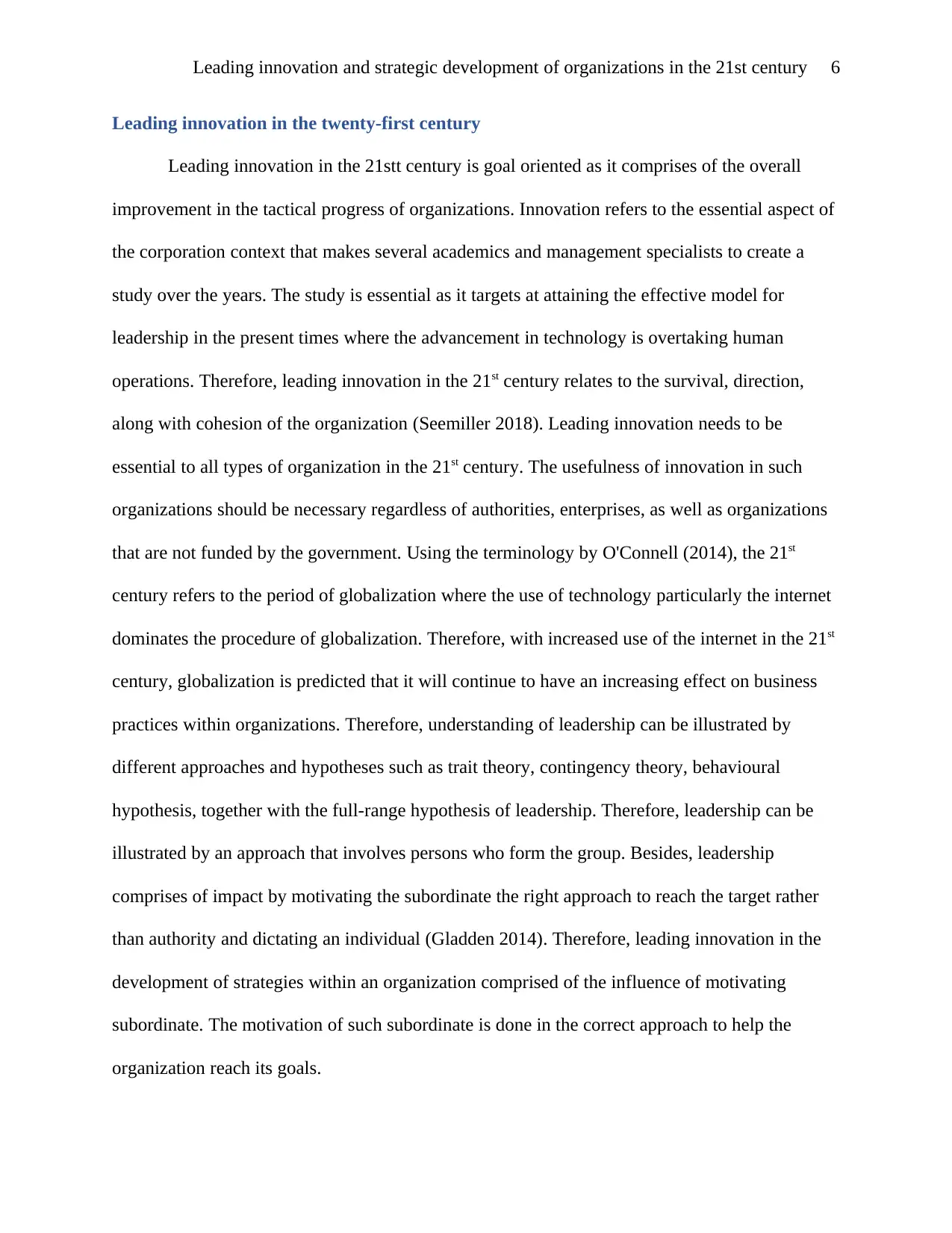
Leading innovation and strategic development of organizations in the 21st century 6
Leading innovation in the twenty-first century
Leading innovation in the 21stt century is goal oriented as it comprises of the overall
improvement in the tactical progress of organizations. Innovation refers to the essential aspect of
the corporation context that makes several academics and management specialists to create a
study over the years. The study is essential as it targets at attaining the effective model for
leadership in the present times where the advancement in technology is overtaking human
operations. Therefore, leading innovation in the 21st century relates to the survival, direction,
along with cohesion of the organization (Seemiller 2018). Leading innovation needs to be
essential to all types of organization in the 21st century. The usefulness of innovation in such
organizations should be necessary regardless of authorities, enterprises, as well as organizations
that are not funded by the government. Using the terminology by O'Connell (2014), the 21st
century refers to the period of globalization where the use of technology particularly the internet
dominates the procedure of globalization. Therefore, with increased use of the internet in the 21st
century, globalization is predicted that it will continue to have an increasing effect on business
practices within organizations. Therefore, understanding of leadership can be illustrated by
different approaches and hypotheses such as trait theory, contingency theory, behavioural
hypothesis, together with the full-range hypothesis of leadership. Therefore, leadership can be
illustrated by an approach that involves persons who form the group. Besides, leadership
comprises of impact by motivating the subordinate the right approach to reach the target rather
than authority and dictating an individual (Gladden 2014). Therefore, leading innovation in the
development of strategies within an organization comprised of the influence of motivating
subordinate. The motivation of such subordinate is done in the correct approach to help the
organization reach its goals.
Leading innovation in the twenty-first century
Leading innovation in the 21stt century is goal oriented as it comprises of the overall
improvement in the tactical progress of organizations. Innovation refers to the essential aspect of
the corporation context that makes several academics and management specialists to create a
study over the years. The study is essential as it targets at attaining the effective model for
leadership in the present times where the advancement in technology is overtaking human
operations. Therefore, leading innovation in the 21st century relates to the survival, direction,
along with cohesion of the organization (Seemiller 2018). Leading innovation needs to be
essential to all types of organization in the 21st century. The usefulness of innovation in such
organizations should be necessary regardless of authorities, enterprises, as well as organizations
that are not funded by the government. Using the terminology by O'Connell (2014), the 21st
century refers to the period of globalization where the use of technology particularly the internet
dominates the procedure of globalization. Therefore, with increased use of the internet in the 21st
century, globalization is predicted that it will continue to have an increasing effect on business
practices within organizations. Therefore, understanding of leadership can be illustrated by
different approaches and hypotheses such as trait theory, contingency theory, behavioural
hypothesis, together with the full-range hypothesis of leadership. Therefore, leadership can be
illustrated by an approach that involves persons who form the group. Besides, leadership
comprises of impact by motivating the subordinate the right approach to reach the target rather
than authority and dictating an individual (Gladden 2014). Therefore, leading innovation in the
development of strategies within an organization comprised of the influence of motivating
subordinate. The motivation of such subordinate is done in the correct approach to help the
organization reach its goals.
⊘ This is a preview!⊘
Do you want full access?
Subscribe today to unlock all pages.

Trusted by 1+ million students worldwide
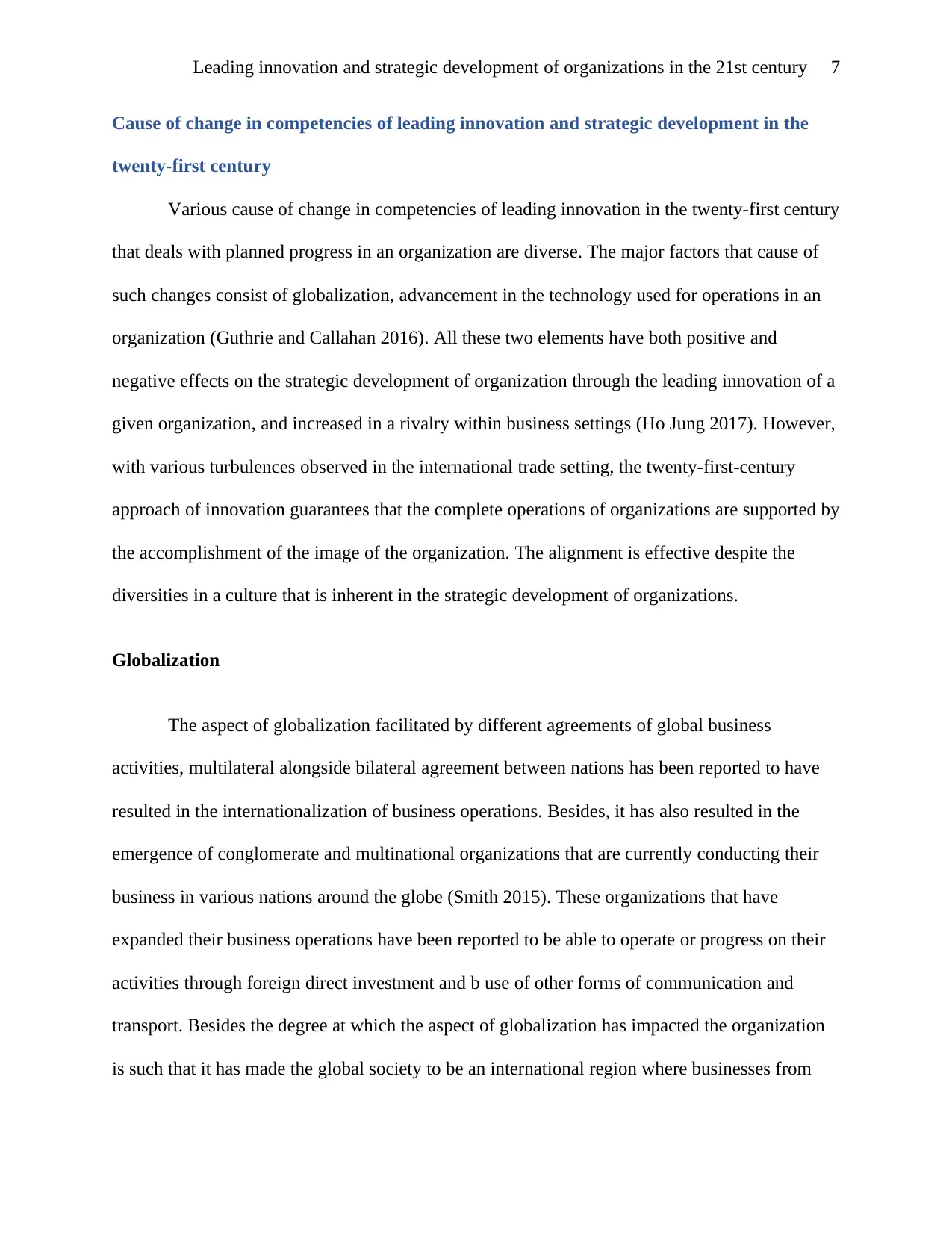
Leading innovation and strategic development of organizations in the 21st century 7
Cause of change in competencies of leading innovation and strategic development in the
twenty-first century
Various cause of change in competencies of leading innovation in the twenty-first century
that deals with planned progress in an organization are diverse. The major factors that cause of
such changes consist of globalization, advancement in the technology used for operations in an
organization (Guthrie and Callahan 2016). All these two elements have both positive and
negative effects on the strategic development of organization through the leading innovation of a
given organization, and increased in a rivalry within business settings (Ho Jung 2017). However,
with various turbulences observed in the international trade setting, the twenty-first-century
approach of innovation guarantees that the complete operations of organizations are supported by
the accomplishment of the image of the organization. The alignment is effective despite the
diversities in a culture that is inherent in the strategic development of organizations.
Globalization
The aspect of globalization facilitated by different agreements of global business
activities, multilateral alongside bilateral agreement between nations has been reported to have
resulted in the internationalization of business operations. Besides, it has also resulted in the
emergence of conglomerate and multinational organizations that are currently conducting their
business in various nations around the globe (Smith 2015). These organizations that have
expanded their business operations have been reported to be able to operate or progress on their
activities through foreign direct investment and b use of other forms of communication and
transport. Besides the degree at which the aspect of globalization has impacted the organization
is such that it has made the global society to be an international region where businesses from
Cause of change in competencies of leading innovation and strategic development in the
twenty-first century
Various cause of change in competencies of leading innovation in the twenty-first century
that deals with planned progress in an organization are diverse. The major factors that cause of
such changes consist of globalization, advancement in the technology used for operations in an
organization (Guthrie and Callahan 2016). All these two elements have both positive and
negative effects on the strategic development of organization through the leading innovation of a
given organization, and increased in a rivalry within business settings (Ho Jung 2017). However,
with various turbulences observed in the international trade setting, the twenty-first-century
approach of innovation guarantees that the complete operations of organizations are supported by
the accomplishment of the image of the organization. The alignment is effective despite the
diversities in a culture that is inherent in the strategic development of organizations.
Globalization
The aspect of globalization facilitated by different agreements of global business
activities, multilateral alongside bilateral agreement between nations has been reported to have
resulted in the internationalization of business operations. Besides, it has also resulted in the
emergence of conglomerate and multinational organizations that are currently conducting their
business in various nations around the globe (Smith 2015). These organizations that have
expanded their business operations have been reported to be able to operate or progress on their
activities through foreign direct investment and b use of other forms of communication and
transport. Besides the degree at which the aspect of globalization has impacted the organization
is such that it has made the global society to be an international region where businesses from
Paraphrase This Document
Need a fresh take? Get an instant paraphrase of this document with our AI Paraphraser
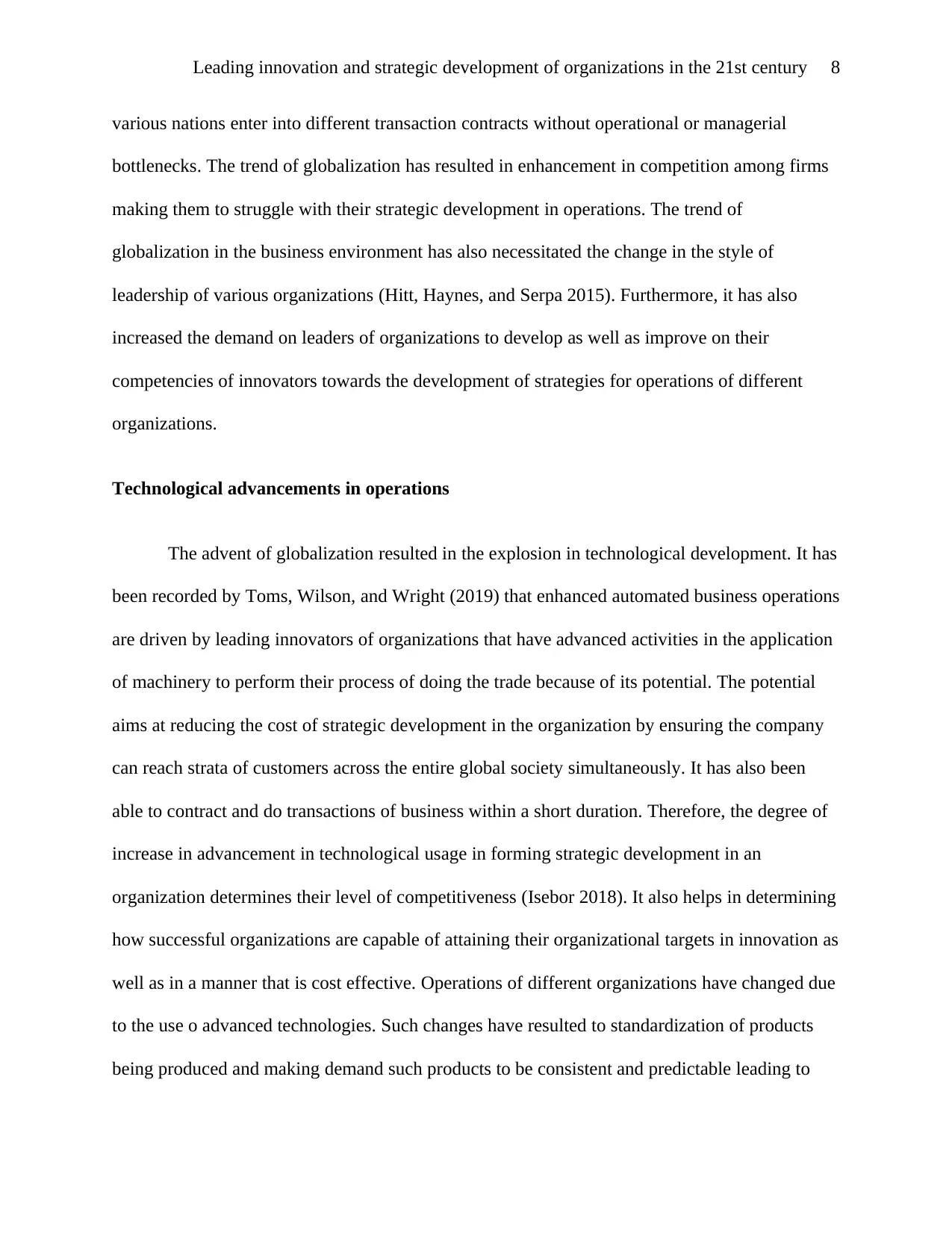
Leading innovation and strategic development of organizations in the 21st century 8
various nations enter into different transaction contracts without operational or managerial
bottlenecks. The trend of globalization has resulted in enhancement in competition among firms
making them to struggle with their strategic development in operations. The trend of
globalization in the business environment has also necessitated the change in the style of
leadership of various organizations (Hitt, Haynes, and Serpa 2015). Furthermore, it has also
increased the demand on leaders of organizations to develop as well as improve on their
competencies of innovators towards the development of strategies for operations of different
organizations.
Technological advancements in operations
The advent of globalization resulted in the explosion in technological development. It has
been recorded by Toms, Wilson, and Wright (2019) that enhanced automated business operations
are driven by leading innovators of organizations that have advanced activities in the application
of machinery to perform their process of doing the trade because of its potential. The potential
aims at reducing the cost of strategic development in the organization by ensuring the company
can reach strata of customers across the entire global society simultaneously. It has also been
able to contract and do transactions of business within a short duration. Therefore, the degree of
increase in advancement in technological usage in forming strategic development in an
organization determines their level of competitiveness (Isebor 2018). It also helps in determining
how successful organizations are capable of attaining their organizational targets in innovation as
well as in a manner that is cost effective. Operations of different organizations have changed due
to the use o advanced technologies. Such changes have resulted to standardization of products
being produced and making demand such products to be consistent and predictable leading to
various nations enter into different transaction contracts without operational or managerial
bottlenecks. The trend of globalization has resulted in enhancement in competition among firms
making them to struggle with their strategic development in operations. The trend of
globalization in the business environment has also necessitated the change in the style of
leadership of various organizations (Hitt, Haynes, and Serpa 2015). Furthermore, it has also
increased the demand on leaders of organizations to develop as well as improve on their
competencies of innovators towards the development of strategies for operations of different
organizations.
Technological advancements in operations
The advent of globalization resulted in the explosion in technological development. It has
been recorded by Toms, Wilson, and Wright (2019) that enhanced automated business operations
are driven by leading innovators of organizations that have advanced activities in the application
of machinery to perform their process of doing the trade because of its potential. The potential
aims at reducing the cost of strategic development in the organization by ensuring the company
can reach strata of customers across the entire global society simultaneously. It has also been
able to contract and do transactions of business within a short duration. Therefore, the degree of
increase in advancement in technological usage in forming strategic development in an
organization determines their level of competitiveness (Isebor 2018). It also helps in determining
how successful organizations are capable of attaining their organizational targets in innovation as
well as in a manner that is cost effective. Operations of different organizations have changed due
to the use o advanced technologies. Such changes have resulted to standardization of products
being produced and making demand such products to be consistent and predictable leading to
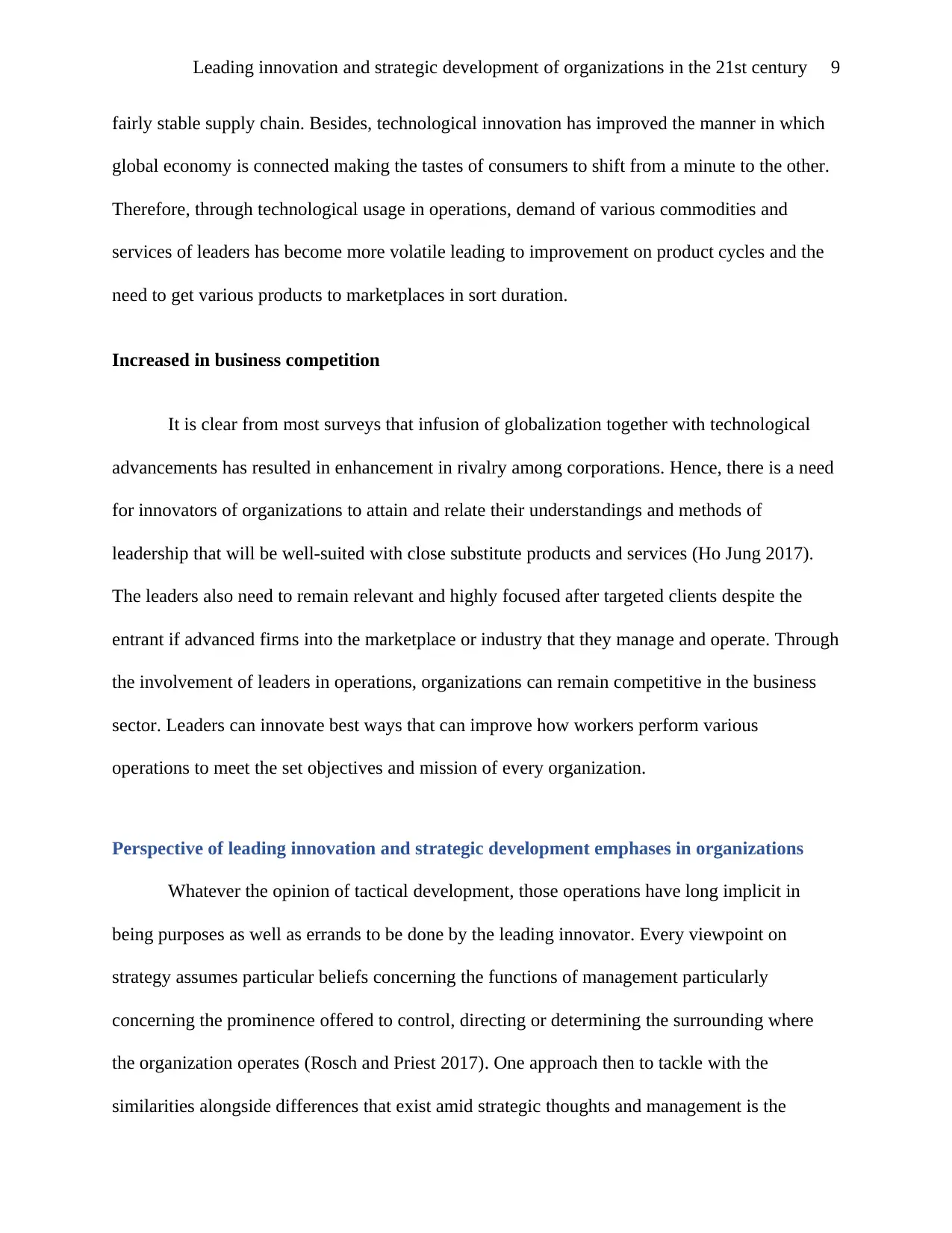
Leading innovation and strategic development of organizations in the 21st century 9
fairly stable supply chain. Besides, technological innovation has improved the manner in which
global economy is connected making the tastes of consumers to shift from a minute to the other.
Therefore, through technological usage in operations, demand of various commodities and
services of leaders has become more volatile leading to improvement on product cycles and the
need to get various products to marketplaces in sort duration.
Increased in business competition
It is clear from most surveys that infusion of globalization together with technological
advancements has resulted in enhancement in rivalry among corporations. Hence, there is a need
for innovators of organizations to attain and relate their understandings and methods of
leadership that will be well-suited with close substitute products and services (Ho Jung 2017).
The leaders also need to remain relevant and highly focused after targeted clients despite the
entrant if advanced firms into the marketplace or industry that they manage and operate. Through
the involvement of leaders in operations, organizations can remain competitive in the business
sector. Leaders can innovate best ways that can improve how workers perform various
operations to meet the set objectives and mission of every organization.
Perspective of leading innovation and strategic development emphases in organizations
Whatever the opinion of tactical development, those operations have long implicit in
being purposes as well as errands to be done by the leading innovator. Every viewpoint on
strategy assumes particular beliefs concerning the functions of management particularly
concerning the prominence offered to control, directing or determining the surrounding where
the organization operates (Rosch and Priest 2017). One approach then to tackle with the
similarities alongside differences that exist amid strategic thoughts and management is the
fairly stable supply chain. Besides, technological innovation has improved the manner in which
global economy is connected making the tastes of consumers to shift from a minute to the other.
Therefore, through technological usage in operations, demand of various commodities and
services of leaders has become more volatile leading to improvement on product cycles and the
need to get various products to marketplaces in sort duration.
Increased in business competition
It is clear from most surveys that infusion of globalization together with technological
advancements has resulted in enhancement in rivalry among corporations. Hence, there is a need
for innovators of organizations to attain and relate their understandings and methods of
leadership that will be well-suited with close substitute products and services (Ho Jung 2017).
The leaders also need to remain relevant and highly focused after targeted clients despite the
entrant if advanced firms into the marketplace or industry that they manage and operate. Through
the involvement of leaders in operations, organizations can remain competitive in the business
sector. Leaders can innovate best ways that can improve how workers perform various
operations to meet the set objectives and mission of every organization.
Perspective of leading innovation and strategic development emphases in organizations
Whatever the opinion of tactical development, those operations have long implicit in
being purposes as well as errands to be done by the leading innovator. Every viewpoint on
strategy assumes particular beliefs concerning the functions of management particularly
concerning the prominence offered to control, directing or determining the surrounding where
the organization operates (Rosch and Priest 2017). One approach then to tackle with the
similarities alongside differences that exist amid strategic thoughts and management is the
⊘ This is a preview!⊘
Do you want full access?
Subscribe today to unlock all pages.

Trusted by 1+ million students worldwide
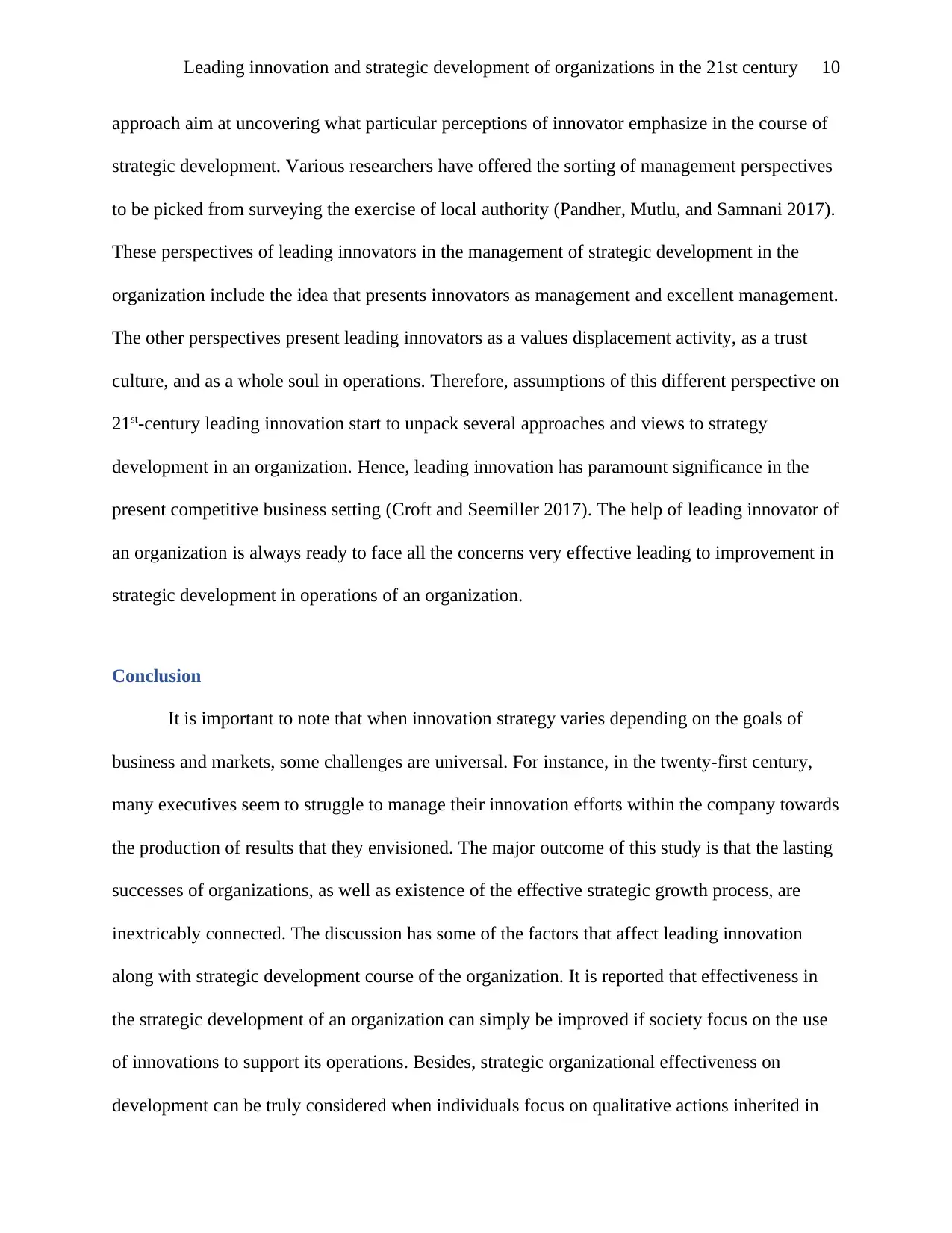
Leading innovation and strategic development of organizations in the 21st century 10
approach aim at uncovering what particular perceptions of innovator emphasize in the course of
strategic development. Various researchers have offered the sorting of management perspectives
to be picked from surveying the exercise of local authority (Pandher, Mutlu, and Samnani 2017).
These perspectives of leading innovators in the management of strategic development in the
organization include the idea that presents innovators as management and excellent management.
The other perspectives present leading innovators as a values displacement activity, as a trust
culture, and as a whole soul in operations. Therefore, assumptions of this different perspective on
21st-century leading innovation start to unpack several approaches and views to strategy
development in an organization. Hence, leading innovation has paramount significance in the
present competitive business setting (Croft and Seemiller 2017). The help of leading innovator of
an organization is always ready to face all the concerns very effective leading to improvement in
strategic development in operations of an organization.
Conclusion
It is important to note that when innovation strategy varies depending on the goals of
business and markets, some challenges are universal. For instance, in the twenty-first century,
many executives seem to struggle to manage their innovation efforts within the company towards
the production of results that they envisioned. The major outcome of this study is that the lasting
successes of organizations, as well as existence of the effective strategic growth process, are
inextricably connected. The discussion has some of the factors that affect leading innovation
along with strategic development course of the organization. It is reported that effectiveness in
the strategic development of an organization can simply be improved if society focus on the use
of innovations to support its operations. Besides, strategic organizational effectiveness on
development can be truly considered when individuals focus on qualitative actions inherited in
approach aim at uncovering what particular perceptions of innovator emphasize in the course of
strategic development. Various researchers have offered the sorting of management perspectives
to be picked from surveying the exercise of local authority (Pandher, Mutlu, and Samnani 2017).
These perspectives of leading innovators in the management of strategic development in the
organization include the idea that presents innovators as management and excellent management.
The other perspectives present leading innovators as a values displacement activity, as a trust
culture, and as a whole soul in operations. Therefore, assumptions of this different perspective on
21st-century leading innovation start to unpack several approaches and views to strategy
development in an organization. Hence, leading innovation has paramount significance in the
present competitive business setting (Croft and Seemiller 2017). The help of leading innovator of
an organization is always ready to face all the concerns very effective leading to improvement in
strategic development in operations of an organization.
Conclusion
It is important to note that when innovation strategy varies depending on the goals of
business and markets, some challenges are universal. For instance, in the twenty-first century,
many executives seem to struggle to manage their innovation efforts within the company towards
the production of results that they envisioned. The major outcome of this study is that the lasting
successes of organizations, as well as existence of the effective strategic growth process, are
inextricably connected. The discussion has some of the factors that affect leading innovation
along with strategic development course of the organization. It is reported that effectiveness in
the strategic development of an organization can simply be improved if society focus on the use
of innovations to support its operations. Besides, strategic organizational effectiveness on
development can be truly considered when individuals focus on qualitative actions inherited in
Paraphrase This Document
Need a fresh take? Get an instant paraphrase of this document with our AI Paraphraser
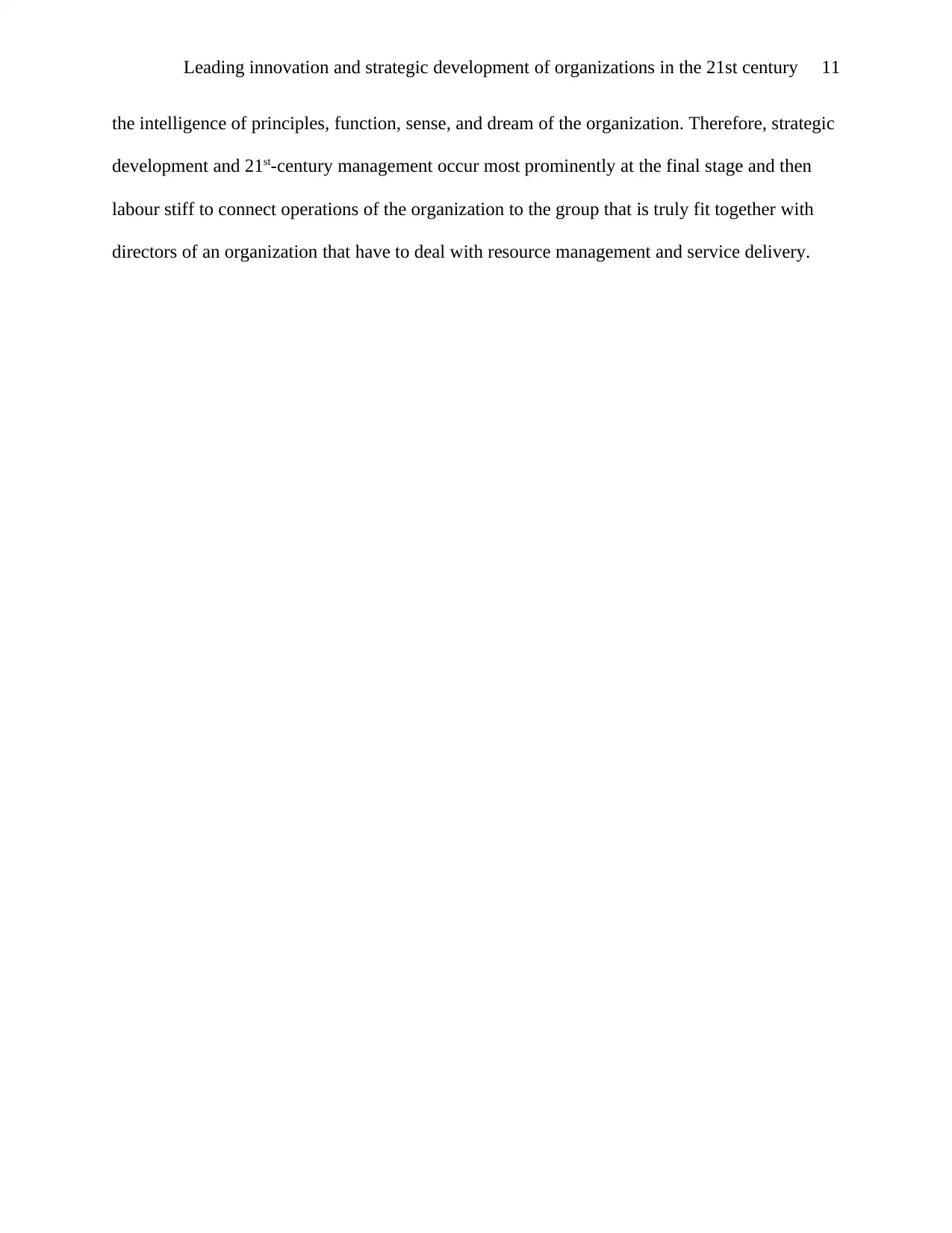
Leading innovation and strategic development of organizations in the 21st century 11
the intelligence of principles, function, sense, and dream of the organization. Therefore, strategic
development and 21st-century management occur most prominently at the final stage and then
labour stiff to connect operations of the organization to the group that is truly fit together with
directors of an organization that have to deal with resource management and service delivery.
the intelligence of principles, function, sense, and dream of the organization. Therefore, strategic
development and 21st-century management occur most prominently at the final stage and then
labour stiff to connect operations of the organization to the group that is truly fit together with
directors of an organization that have to deal with resource management and service delivery.
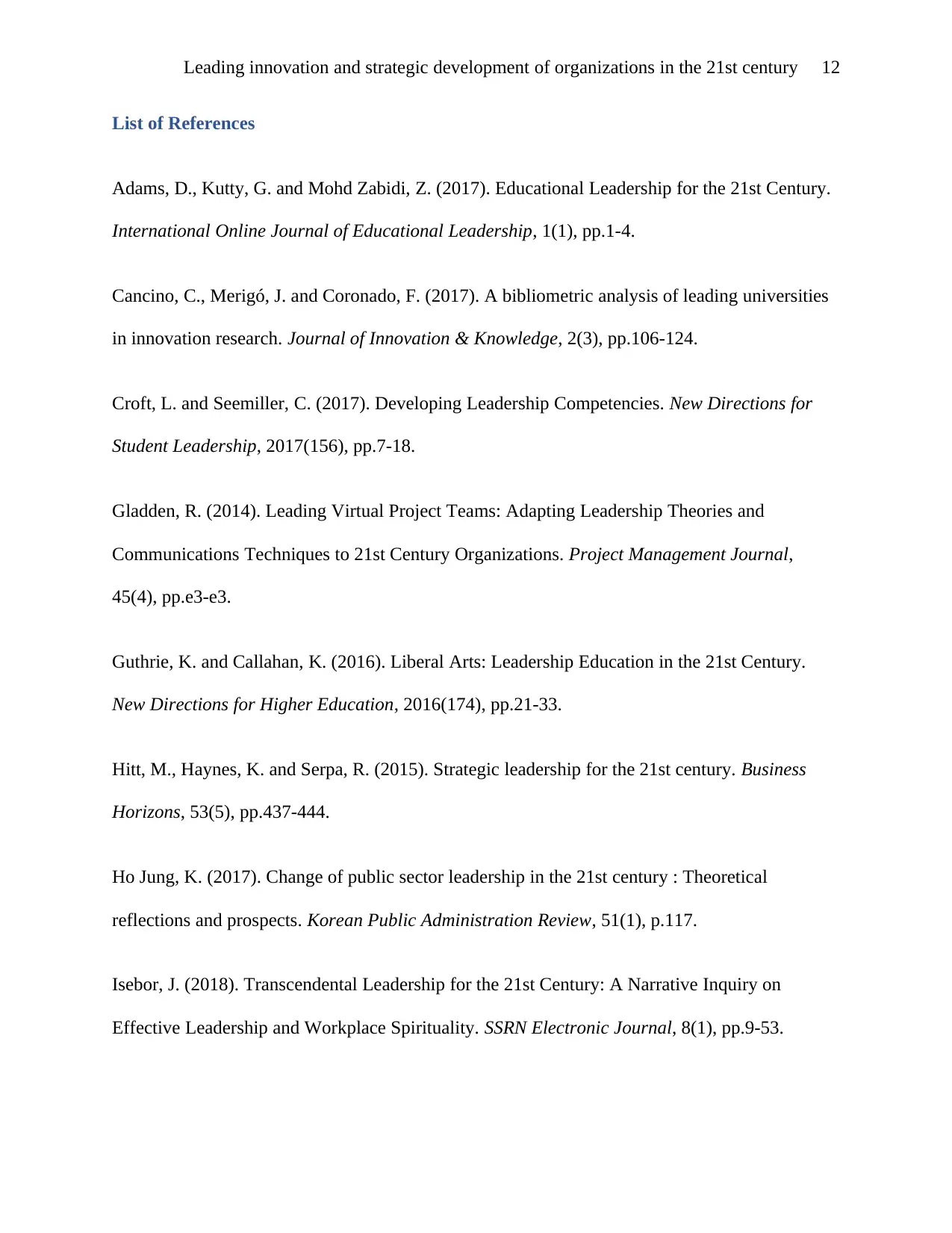
Leading innovation and strategic development of organizations in the 21st century 12
List of References
Adams, D., Kutty, G. and Mohd Zabidi, Z. (2017). Educational Leadership for the 21st Century.
International Online Journal of Educational Leadership, 1(1), pp.1-4.
Cancino, C., Merigó, J. and Coronado, F. (2017). A bibliometric analysis of leading universities
in innovation research. Journal of Innovation & Knowledge, 2(3), pp.106-124.
Croft, L. and Seemiller, C. (2017). Developing Leadership Competencies. New Directions for
Student Leadership, 2017(156), pp.7-18.
Gladden, R. (2014). Leading Virtual Project Teams: Adapting Leadership Theories and
Communications Techniques to 21st Century Organizations. Project Management Journal,
45(4), pp.e3-e3.
Guthrie, K. and Callahan, K. (2016). Liberal Arts: Leadership Education in the 21st Century.
New Directions for Higher Education, 2016(174), pp.21-33.
Hitt, M., Haynes, K. and Serpa, R. (2015). Strategic leadership for the 21st century. Business
Horizons, 53(5), pp.437-444.
Ho Jung, K. (2017). Change of public sector leadership in the 21st century : Theoretical
reflections and prospects. Korean Public Administration Review, 51(1), p.117.
Isebor, J. (2018). Transcendental Leadership for the 21st Century: A Narrative Inquiry on
Effective Leadership and Workplace Spirituality. SSRN Electronic Journal, 8(1), pp.9-53.
List of References
Adams, D., Kutty, G. and Mohd Zabidi, Z. (2017). Educational Leadership for the 21st Century.
International Online Journal of Educational Leadership, 1(1), pp.1-4.
Cancino, C., Merigó, J. and Coronado, F. (2017). A bibliometric analysis of leading universities
in innovation research. Journal of Innovation & Knowledge, 2(3), pp.106-124.
Croft, L. and Seemiller, C. (2017). Developing Leadership Competencies. New Directions for
Student Leadership, 2017(156), pp.7-18.
Gladden, R. (2014). Leading Virtual Project Teams: Adapting Leadership Theories and
Communications Techniques to 21st Century Organizations. Project Management Journal,
45(4), pp.e3-e3.
Guthrie, K. and Callahan, K. (2016). Liberal Arts: Leadership Education in the 21st Century.
New Directions for Higher Education, 2016(174), pp.21-33.
Hitt, M., Haynes, K. and Serpa, R. (2015). Strategic leadership for the 21st century. Business
Horizons, 53(5), pp.437-444.
Ho Jung, K. (2017). Change of public sector leadership in the 21st century : Theoretical
reflections and prospects. Korean Public Administration Review, 51(1), p.117.
Isebor, J. (2018). Transcendental Leadership for the 21st Century: A Narrative Inquiry on
Effective Leadership and Workplace Spirituality. SSRN Electronic Journal, 8(1), pp.9-53.
⊘ This is a preview!⊘
Do you want full access?
Subscribe today to unlock all pages.

Trusted by 1+ million students worldwide
1 out of 13
Related Documents
Your All-in-One AI-Powered Toolkit for Academic Success.
+13062052269
info@desklib.com
Available 24*7 on WhatsApp / Email
![[object Object]](/_next/static/media/star-bottom.7253800d.svg)
Unlock your academic potential
Copyright © 2020–2025 A2Z Services. All Rights Reserved. Developed and managed by ZUCOL.





